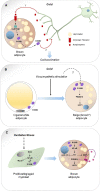S100 proteins in obesity: liaisons dangereuses
- PMID: 31363816
- PMCID: PMC11104817
- DOI: 10.1007/s00018-019-03257-4
S100 proteins in obesity: liaisons dangereuses
Abstract
Obesity is an endemic pathophysiological condition and a comorbidity associated with hypercholesterolemia, hypertension, cardiovascular disease, type 2 diabetes mellitus, and cancer. The adipose tissue of obese subjects shows hypertrophic adipocytes, adipocyte hyperplasia, and chronic low-grade inflammation. S100 proteins are Ca2+-binding proteins exclusively expressed in vertebrates in a cell-specific manner. They have been implicated in the regulation of a variety of functions acting as intracellular Ca2+ sensors transducing the Ca2+ signal and extracellular factors affecting cellular activity via ligation of a battery of membrane receptors. Certain S100 proteins, namely S100A4, the S100A8/S100A9 heterodimer and S100B, have been implicated in the pathophysiology of obesity-promoting macrophage-based inflammation via toll-like receptor 4 and/or receptor for advanced glycation end-products ligation. Also, serum levels of S100A4, S100A8/S100A9, S100A12, and S100B correlate with insulin resistance/type 2 diabetes, metabolic risk score, and fat cell size. Yet, secreted S100B appears to exert neurotrophic effects on sympathetic fibers in brown adipose tissue contributing to the larger sympathetic innervation of this latter relative to white adipose tissue. In the present review we first briefly introduce S100 proteins and then critically examine their role(s) in adipose tissue and obesity.
Keywords: Adipocyte; Brown adipose tissue; Cytokine; Inflammation; Macrophage; Receptor; Transdifferentiation; White adipose tissue.
Conflict of interest statement
The authors declare no conflict of interest.
Figures



Similar articles
-
Increased levels of calprotectin in obesity are related to macrophage content: impact on inflammation and effect of weight loss.Mol Med. 2011;17(11-12):1157-67. doi: 10.2119/molmed.2011.00144. Epub 2011 Jul 5. Mol Med. 2011. PMID: 21738950 Free PMC article.
-
Role of microbiota-derived lipopolysaccharide in adipose tissue inflammation, adipocyte size and pyroptosis during obesity.Nutr Res Rev. 2018 Dec;31(2):153-163. doi: 10.1017/S0954422417000269. Epub 2018 Jan 24. Nutr Res Rev. 2018. PMID: 29362018 Review.
-
RAGE: a single receptor for several ligands and different cellular responses: the case of certain S100 proteins.Curr Mol Med. 2007 Dec;7(8):711-24. doi: 10.2174/156652407783220688. Curr Mol Med. 2007. PMID: 18331229 Review.
-
S100/Calgranulin-mediated inflammation accelerates left ventricular hypertrophy and aortic valve sclerosis in chronic kidney disease in a receptor for advanced glycation end products-dependent manner.Arterioscler Thromb Vasc Biol. 2014 Jul;34(7):1399-411. doi: 10.1161/ATVBAHA.114.303508. Epub 2014 May 22. Arterioscler Thromb Vasc Biol. 2014. PMID: 24855059 Free PMC article.
-
[Role of chronic inflammation in adipose tissue in the pathophysiology of obesity].Nihon Rinsho. 2013 Feb;71(2):225-30. Nihon Rinsho. 2013. PMID: 23631197 Review. Japanese.
Cited by
-
The Multifaceted S100B Protein: A Role in Obesity and Diabetes?Int J Mol Sci. 2024 Jan 8;25(2):776. doi: 10.3390/ijms25020776. Int J Mol Sci. 2024. PMID: 38255850 Free PMC article. Review.
-
Targeting Nitric Oxide: Say NO to Metastasis.Clin Cancer Res. 2023 May 15;29(10):1855-1868. doi: 10.1158/1078-0432.CCR-22-2791. Clin Cancer Res. 2023. PMID: 36520504 Free PMC article. Review.
-
Molecular Characteristics of RAGE and Advances in Small-Molecule Inhibitors.Int J Mol Sci. 2021 Jun 27;22(13):6904. doi: 10.3390/ijms22136904. Int J Mol Sci. 2021. PMID: 34199060 Free PMC article. Review.
-
Journey to a Receptor for Advanced Glycation End Products Connection in Severe Acute Respiratory Syndrome Coronavirus 2 Infection: With Stops Along the Way in the Lung, Heart, Blood Vessels, and Adipose Tissue.Arterioscler Thromb Vasc Biol. 2021 Feb;41(2):614-627. doi: 10.1161/ATVBAHA.120.315527. Epub 2020 Dec 17. Arterioscler Thromb Vasc Biol. 2021. PMID: 33327744 Free PMC article. Review.
-
S100 Proteins in Fatty Liver Disease and Hepatocellular Carcinoma.Int J Mol Sci. 2022 Sep 20;23(19):11030. doi: 10.3390/ijms231911030. Int J Mol Sci. 2022. PMID: 36232334 Free PMC article. Review.
References
Publication types
MeSH terms
Substances
Grants and funding
LinkOut - more resources
Full Text Sources
Medical
Research Materials
Miscellaneous

